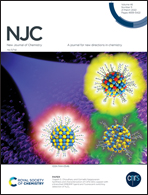Synthesis and exploration of configurational dynamics in equilibrating E/Z 2-aryliminothiazolidin-4-ones using NMR and estimation of thermodynamic parameters†
Abstract
In the present study, 2-aryliminothiazolidin-4-ones (3 and 5) were utilized as dynamic chemical systems, whose different states are modulated in a reversible fashion through specific chemical stimuli. The in-depth NMR investigation revealed that the magnitude of rotational energy barrier (ΔG‡) is affected markedly by (1) the solvent polarity; (2) the electronic nature of the ring system present on the exocyclic C![[double bond, length as m-dash]](https://www.rsc.org/images/entities/char_e001.gif) N bond and (3) the temperature of the system. The derivatives of 5-(3-arylallylidene)-2-(arylimino)thiazolidin-4-one exist in two isomeric forms at room temperature in DMSO-d6: (2E,5Z,7E) ⇆ (2Z,5Z,7E). The stereodynamics of the synthesized derivatives (5a–5t) has been investigated using variable temperature dynamic 1H-NMR (VT DNMR). The ΔG‡ values (≈15 kcal mol−1) estimated for the dynamic process depict a significant barrier between two forms in solution at ambient temperature. To go a step further, line shape analysis was also performed to get a clear understanding of the equilibration mechanism.
N bond and (3) the temperature of the system. The derivatives of 5-(3-arylallylidene)-2-(arylimino)thiazolidin-4-one exist in two isomeric forms at room temperature in DMSO-d6: (2E,5Z,7E) ⇆ (2Z,5Z,7E). The stereodynamics of the synthesized derivatives (5a–5t) has been investigated using variable temperature dynamic 1H-NMR (VT DNMR). The ΔG‡ values (≈15 kcal mol−1) estimated for the dynamic process depict a significant barrier between two forms in solution at ambient temperature. To go a step further, line shape analysis was also performed to get a clear understanding of the equilibration mechanism.



 Please wait while we load your content...
Please wait while we load your content...